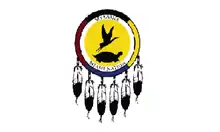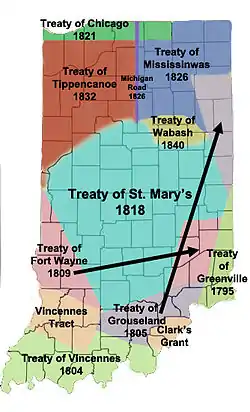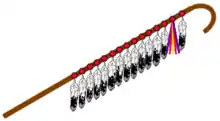 Miami Tribe of Oklahoma flag | |
| Total population | |
|---|---|
| 3,908[1] | |
| Regions with significant populations | |
| United States (Oklahoma) | |
| Languages | |
| Myaamia, English | |
| Religion | |
| Christianity, traditional tribal religion | |
| Related ethnic groups | |
| Peoria, Kaskaskia, Shawnee people, Wea, Illinois, and other Algonquian peoples |
The Miami Tribe of Oklahoma (Miami-Illinois: myaamionki noošonke siipionki, meaning: "Miami homelands along the Neosho River)[2] is the only federally recognized Native American tribe of Miami Indians in the United States.[3] The people are descended from Miami who were removed in the 19th century from their traditional territory in present-day Indiana, Michigan and Ohio.
Language
Tribal members traditionally spoke the Miami-Illinois language, one of the Algonquian languages, but few do today. The tribe is partners with Miami University, and one result of that partnership is the Myaamia Center. The Myaamia Center is engaged in the work of language and culture revitalization. The Myaamia language is particularly well-documented in early sources (including a complete Illinois-French dictionary).[4] The tribe and the university work together to conduct research projects to revitalize Miami language and culture, and to offer university students opportunities to visit and work with the tribe on various projects.[5]
Government and programs
The headquarters of the Miami Tribe are based in Miami, Oklahoma. Of the 3,908 enrolled tribal members, 775 live in the state of Oklahoma. Enrollment in the tribe is based on documented lineal descent;[1] they do not have a blood quantum requirement.
Douglas Lankford is the Chief of the Miami Tribe of Oklahoma. The Miami Tribe issues its own tribal vehicle tags and operate their own housing authority.[1]
Aatotankiki Myaamiaki is the Miami Nation quarterly newspaper.[6] The tribe is in the process of building the Myaamia Complex, for the benefit of tribal elders, to house the food program and tribal library.[7]
Economic development
In the interest of providing economic development for the community, the tribe created Miami Nation Enterprises, which oversees tribally owned companies. These include Miami Business Services, which provides personnel, information technologies, and business supplies; Miami Designs, which provides graphic art and promotional materials; Miami Cineplex, a movie theater and arcade; and TSI Global Companies, a systems integrator with expertise in audiovisual systems, low voltage cabling, security and access control, as well as electrical contracting.[8] Additionally the tribe owns one smokeshop and two casinos (Prairie Sun and Prairie Moon). Their estimated annual tribal economic impact is $16,700,000.[1]
Culture
The tribe holds an annual powwow late in June and a stomp dance every winter in late January. The Myaamia Center continues research directed by the Miami Tribe of Oklahoma to revitalize language and culture.[3]
History
The Miami Tribe of Oklahoma is an Eastern Woodlands tribe, who traditionally spoke the Miami-Illinois language, a language of the Algonquin family. The name 'Miami' derives from Myaamia (plural Myaamiaki), the tribe's autonym (name for themselves) in their Algonquian language; it appears to have been derived from an older term meaning 'downstream people’. Some scholars contended the Miami called themselves the Twightwee (also spelled Twatwa), supposedly an onomatopoeic reference to their sacred bird, the sandhill crane. However, recent studies have shown that Twightwee derives from the Delaware language exonym name for the Miamis, tuwéhtuwe, a name of unknown etymology.[9] Some Miami have stated that this was only a name used by other tribes for the Miami, and not their autonym. They also use Mihtohseeniaki, "the people." The Miami continue to employ this autonym today.
Miami society was divided into clans, led by hereditary chiefs.[3] They had a patrilineal system of kinship, with descent and inheritance passing through the paternal lines. Children were considered born into their father's clans but clan mothers were highly influential who had approval over hereditary chiefs.
They constructed villages with long houses, occupied by related families. The Miami were farmers and were known for developing a unique type of white corn. Traditionally, they played double ball, the moccasin game, and darts.[3]



Like all tribes who had reservations in what became Oklahoma, in the late 19th century the Miami endured their communal lands being broken up by the Dawes Act, which allotted land to individual households with the thought to encourage assimilation as farmers. In practice, it resulted in the loss of much tribal land, as speculators took advantage of the Miami. Similarly, the Curtis Act of 1898 ended tribal government and the federal Bureau of Indian Affairs became an intermediary administration.
The Miami persevered and in the 1930s, they re-organized their own tribal government under the Oklahoma Indian Welfare Act, independent of the Peoria people. The Miami ratified their constitution on August 16, 1939, which established a representative government with elected council and chief.[10] In 1996, the Miami Tribe of Oklahoma changed its constitution to permit any descendant of people on certain historical roles to join, and since then hundreds of Indiana-based Miami have become members. Today the Oklahoma-based Miami tribe has about 5,600 enrolled members.[16]
On February 5, 2014, Rep. Markwayne Mullin (R, OK-2) introduced the bill To revoke the charter of incorporation of the Miami Tribe of Oklahoma at the request of that tribe (H.R. 4002; 113th Congress) into the United States House of Representatives.[11] The bill would accept the request of the Miami Tribe of Oklahoma to revoke the charter of incorporation issued to that tribe and ratified by its members on June 1, 1940.[11][12] Based on information provided by the Bureau of Indian Affairs, the Congressional Budget Office (CBO) estimates that implementing the legislation would have no effect on the federal budget. The tribe has not been operating under the charter for the last several decades. Enacting H.R. 4002 would not affect direct spending or revenues; therefore, pay-as-you-go procedures do not apply.[13] H.R. 4002 contains no intergovernmental or private-sector mandates as defined in the Unfunded Mandates Reform Act.[14] The bill was scheduled to be voted on by the House on June 23, 2014.[12] The Department of the Interior testified that they had no objection to the charter being revoked saying that the "decision whether to maintain or revoke such a charter ultimately should be the Tribe's."[15]
In January 2015, the Miami Tribe of Oklahoma built a cultural resources office in Fort Wayne, Indiana, which will include providing services to tribal members who live in Indiana.[16]
The Miami Tribe of Oklahoma has ties with Miami University in Ohio.[17][18]
Notable tribal members
- Daryl Baldwin, language revitalization
- Katrina Mitten, beadwork artist
See also
Notes
- 1 2 3 4 2011 Oklahoma Indian Nations Pocket Pictorial Directory. Archived April 24, 2012, at the Wayback Machine Oklahoma Indian Affairs Commission. 2011: 21. Retrieved January 4, 2012.
- ↑ Miami-Illinoi Dictionary, "myaami- (n.an) Miami person"Link
- 1 2 3 4 Koenig, Pamela. Miami. Oklahoma Historical Society's Encyclopedia of Oklahoma History & Culture. (retrieved 24 Feb 09)
- ↑ Anderton, Alice, PhD. Status of Indian Languages in Oklahoma. Archived September 17, 2010, at the Wayback Machine Intertribal Wordpath Society. 2009 (Feb 24, 2009)
- ↑ Statement of Purpose, The Myaamia Center at Miami University, 2013 (retrieved October 23, 2013)
- ↑ Atotankiki Myaamiaki: Miami Nation Newspaper. Archived November 5, 2008, at the Wayback Machine The Sovereign Miami Tribe of Oklahoma. (retrieved February 24, 2009)
- ↑ Special Projects. Archived February 22, 2009, at the Wayback Machine The Sovereign Miami Tribe of Oklahoma. (retrieved February 24, 2009)
- ↑ "About Our Companies". Miami Nation Enterprises. Retrieved December 21, 2021.
- ↑ Costa, David J. 2000. Miami-Illinois Tribe Names. In John Nichols, ed., Papers of the Thirty-first Algonquian Conference, pp. 30-53. Winnipeg: University of Manitoba
- ↑ "Constitution of the Miami Tribe of Oklahoma." Native American Constitution and Law Digitization Project. (retrieved March 1, 2010)
- 1 2 "H.R. 4002 - Summary". United States Congress. Retrieved June 23, 2014.
- 1 2 Krehbiel, Randy (June 22, 2014). "D.C. Report: Vote to revoke Miami Tribe charter expected". Tulsa World. Retrieved June 24, 2014.
- ↑ ["CBO - H.R. 4002". Congressional Budget Office. Retrieved June 23, 2014.]
- ↑ ["CBO - H.R. 4002". Congressional Budget Office. Retrieved June 23, 2014.]
- ↑ Washburn, Kevin (March 27, 2014). "Testimony of Kevin Washburn on H.R. 4002". United States Department of the Interior. Retrieved June 24, 2014.
- ↑ Indianz.com January 15, 2015
- ↑ Relationship with Miami University
- ↑ Indianz.com May 10, 2018
References
- Anson, Bert. The Miami Indians, Norman: University of Oklahoma Press, 2000. ISBN 978-0-8061-3197-9.